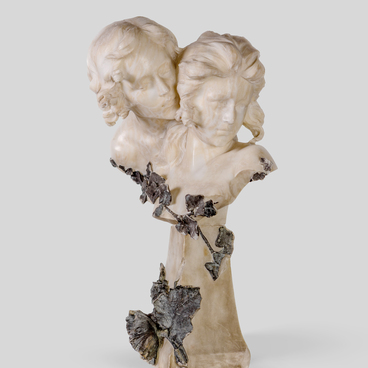The Ivanovo Museum of Local History named after Dmitry Burylin presents a sculptural portrait of Francesco Petrarca, or simply Petrarch — the greatest poet of the Middle Ages.
Petrarch was born in Arezzo on July 20, 1304. He was the son of Pietro di Parenzo — a Florentine lawyer who was exiled from Florence at the same time as Dante for supporting the party of White Guelphs. Parenzo had a nickname — Petracco, so the poet’s pseudonym might have been inspired by this nickname. The only thing Francesco Petrarca inherited after his father’s death was a manuscript of Virgil’s works. At some point, Petrarch became a priest — a decision made out of the difficulty of his financial situation and the need for spiritual enlightenment after graduating from the university. He moved to Avignon to live at the Papacy court. In 1327, Petrarch first saw Laura de Noves. His unrequited love for her prompted him to write poems, which would later be recognized as masterpieces of Italian poetry.
Petrarch enjoyed the greatest popularity from his poems written in Italian. The vast majority of them were dedicated to a woman called Laura (her full name remains a mystery to this day, and Laura de Noves is the most suitable candidate for the role of Petrarch’s muse). The few details that the poet provided about the woman were that her name was Laura, she was first seen by the poet on April 6, 1327 in the church of Santa Chiara and died on April 6, 1348. After Laura’s death, Francesco Petrarca spent ten years poetizing his love.
Petrarch’s Italian sonnets, canzones, and madrigals influenced not only poetry but also music. For example, Franz Liszt composed Petrarch Sonnets for piano after being deeply impressed by the poems dedicated to Laura. Even during Petrarch’s lifetime, his literary works were appreciated by the public, and as a result he received invitations to become appointed as a poet laureate from Naples, Paris and Rome (which came almost at the same time). He chose Rome, where in 1341, on Easter-day, he was crowned in the Capitol with the laurel wreath of the poet.
Up until 1353, Petrarch lived in his estate in
Vaucluse, leaving it only for traveling or preaching missions. He spent the
last months of his life in a small village called Arquà. The poet died there on
the night of July 19, 1374, just one day before his 70th birthday. According
to legend, Petrarch died at his table sometime during the night while working
on the biography of Caesar, with a pen in his hand. He was buried in the local cemetery.



